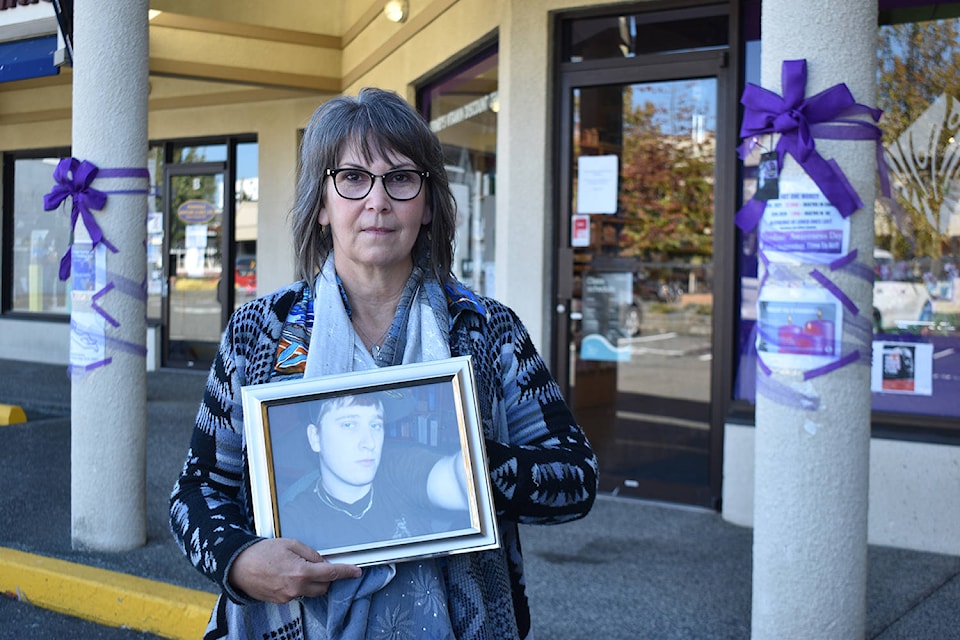The photos of three young men tied to concrete columns ringed by purple ribbons and bows have turned an unassuming commercial plaza near the corner of Sidney’s Beacon Avenue and Fifth Street into a local memorial for the victims of the overdose crisis gripping British Columbia and Canada.
One of those pictures shows the son of Niki Lucas, Dustin, who was 27 years old when he died of an opioid overdose in February 2016. The other two are of Bobby Thompson and Joe Walker.
“He was right at the start of the crisis,” said Lucas of her son, who died of an accidental drug overdose. “And that is the word that we got from the RCMP — ‘oh, it was a bad batch,’” she said. “He was in Edmonton at the time. I think four people died that night.”
Lucas speaks with a matter-of-fact tone as she shares these details, their true depth and pain forever hidden from those on the outside. But the memorial that has sprung up around Lucas’ place of work manifests how many are mourning overdose victims as Canadians mark International Overdose Awareness Day (IOAD) on Aug. 31 with events across the country.
RELATED: Purple ribbons a visual show of opioid crisis grief, while families press for more supports
Locally, Greater Victoria residents can observe a live-streamed candlelight vigil at the Horticulture Centre of the Pacific hosted by Moms Stop The Harm (MSTH), a group advocating for access to a safe supply of pharmaceutical-grade substances and the decriminalization of illicit substances for personal use, among other goals as part of a broader campaign to end substance use related stigma, harms and death.
For Lucas, a local member of MSTH, this abstract goal means that she has to revisit her son’s death. “My mind will be there,” said Lucas, when asked about the upcoming vigil. “Tears will probably come at some point. It will be emotional.”
Lucas said she has experienced times, when she did not want to do anything to mark International Overdose Awareness Day, only to change her mind later.
“My conscience won’t let me (sit out),” she said, noting existing policies have failed to make a difference. “Believe me, each time I do it, I probably fall back 100 steps for a couple of weeks and then I pull myself back up again.”
An element of atonement is also evident. “There are times when I think that I failed him in life, so this is the way I can somehow help, which is a skewed way of thinking, but it is real and I think if you ask most moms, they will think that way because moms are supposed to save their kids.”
RELATED: Overdose advisory issued for Greater Victoria
RELATED: Greater Victoria drug checking increases alongside overdose deaths
The numbers that help to explain Lucas’ engagement are certainly stark. The Government of Canada has recorded 21,174 apparent opioid toxicity deaths between January 2016 and December 2020. Since the start of the COVID-19 pandemic, the federal government has recorded 5,148 apparent opioid toxicity deaths between April and December 2020, an increase of 89 per cent from the same time period in 2019 with 2,722 deaths. Notably, 96 per cent of all 6,214 apparent opioid toxicity deaths in 2020 were accidental.
British Columbia generally and Greater Victoria are local epicentres of this national crisis as some 1,728 British Columbians died in 2020 with 851 having already died between January and May 2021. Victoria (65), along with Vancouver (199) and Surrey (108), having recorded the highest number of illicit drug toxicity deaths through the first five months of 2021.
The medical community has certainly recognized the public dimension of these personal tragedies. British Columbia’s former health officer Dr. Perry Kendall declared opioid-related overdose deaths a public health emergency in April 2016 and both the provincial and federal governments have committed resources to fight this crisis.
RELATED: B.C. VIEWS: Time to listen to the doctors and legalize opioid drugs
RELATED: Legalizing hard drugs not a ‘panacea’ to opioids crisis, Trudeau says
While Lucas acknowledges these aspects, she faults the political class for not doing more. Federal politicians currently campaigning do not give the issue the attention it deserves, she said, as it competes with the COVID-19 pandemic for attention.
“That is because of what it is in comparison to the stigma of the overdose crisis. And that is why the overdose crisis wasn’t taken care of like it should have been in the beginning because of who it affects — or who they think it affects.”
Contrary to popular images, the main victims of the crisis are men in their prime years with established professional careers. According to the federal government, 77 per cent of accidental apparent opioid toxicity deaths in 2020 were men with the majority of deaths among individuals aged 20 to 49 years for both men and women.
That aspect is lost, said Lucas. “It’s their parents, it’s their wives, it’s their children finding them, passed away in their cars, in their rooms, in their yards,” she said. “That’s who is dying from this.”
Lucas sounded frustrated by the lack of action from leading political figures, but nonetheless urged interested parties to get active.
“We are trying to save your children, it’s too late for ours.”
Do you have a story tip? Email: vnc.editorial@blackpress.ca.
Follow us on Twitter and Instagram, and like us on Facebook.
